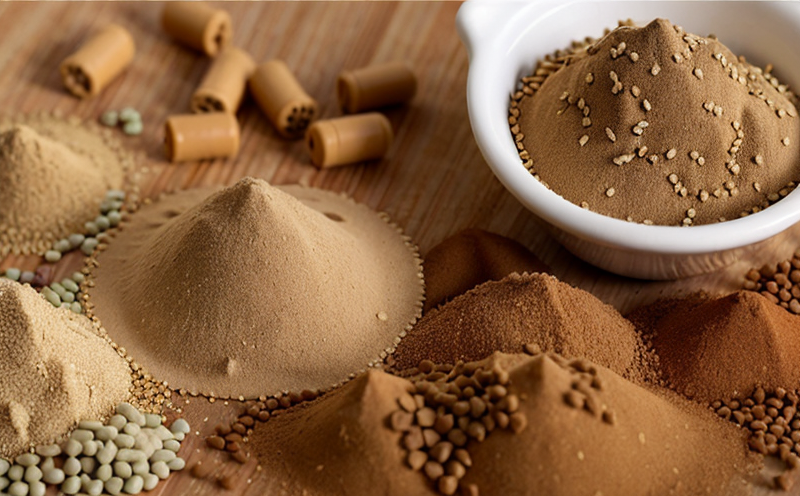Flumequine Residue Testing in Animal Feed
The presence of veterinary drugs such as flumequine in animal feed can have significant implications on food safety and public health. Flumequine is a fluoroquinolone antimicrobial agent used primarily to treat bacterial infections in animals, but its residues in animal products could pose risks if they exceed safe limits. Our laboratory offers comprehensive testing services for flumequine residue detection in animal feeds, ensuring compliance with international standards and regulatory requirements.
Flumequine residue testing is critical for maintaining the integrity of the food chain, especially as concerns about antibiotic resistance grow globally. By providing accurate and reliable results, our laboratory supports stakeholders in the agricultural sector to ensure that animal feed complies with regulations. This service helps to protect both human health and the environment by minimizing unnecessary exposure to antimicrobial residues.
The testing process involves several steps, including sample preparation, extraction, purification, quantification, and confirmation using validated analytical methods. Our laboratory adheres to stringent quality control measures throughout these stages to ensure consistent and accurate results. We use advanced instruments such as high-performance liquid chromatography (HPLC) or gas chromatography-mass spectrometry (GC-MS) for precise analysis.
Compliance with relevant standards is essential when conducting flumequine residue testing. Our laboratory follows internationally recognized guidelines, including ISO 17025 and EU regulations on veterinary drug residues in feedstuffs. These standards provide a framework for ensuring the accuracy, precision, and reliability of our test results.
Sample preparation plays a crucial role in achieving accurate flumequine residue testing outcomes. Proper handling and processing of samples are vital to ensure they represent the true composition of the animal feed being tested. This includes thorough mixing, subsampling, and appropriate preservation techniques before extraction.
| Key Steps in Sample Preparation |
|---|
| Mixing |
| Subsampling |
| Preservation Techniques |
The choice of analytical method depends on various factors, including the matrix type and desired sensitivity. High-performance liquid chromatography (HPLC) is commonly used for its ability to separate complex mixtures effectively while providing robust detection capabilities. Gas chromatography-mass spectrometry (GC-MS), when paired with HPLC, offers even higher resolution and specificity.
Once the sample has been prepared, extraction follows using solvents like methanol or acetonitrile under controlled conditions. This step aims to transfer flumequine residues from solid matrices into solution form for easier analysis. After extraction, purification steps may be necessary to eliminate interfering substances before quantification.
Quantification involves measuring the concentration of flumequine in the prepared samples using calibrated standards. This process requires precise calibration and standardization procedures to ensure accurate measurement results. Confirmation tests are also conducted to verify the identity and purity of detected peaks, ensuring that only true positives are reported.
The final output from our laboratory includes detailed reports outlining all findings along with recommendations for corrective actions if necessary. These documents serve as valuable tools for quality managers and compliance officers responsible for overseeing feed production processes within their organizations.
Applied Standards
Our flumequine residue testing adheres to several key standards that ensure accuracy, consistency, and reliability across all samples analyzed. The primary standard followed is ISO 17025, which sets forth requirements for competence in testing and calibration laboratories. Additionally, we comply with EU directives related specifically to veterinary drug residues in feedstuffs.
ISO 17025 emphasizes the importance of maintaining proficiency through regular internal audits and external reviews conducted by independent bodies recognized internationally. By adhering to this standard, our laboratory demonstrates its commitment to delivering high-quality results that meet both national and international expectations.
The EU directive on veterinary drug residues in feedstuffs provides specific guidelines for monitoring and controlling the presence of flumequine within animal feeds. These regulations outline acceptable limits based on risk assessment considerations aimed at protecting public health while promoting responsible use practices among producers.
Industry Applications
- Agriculture: Ensuring safe feed products for livestock to prevent contamination leading to potential human health risks.
- Food Safety: Guaranteeing compliance with regulatory frameworks protecting consumers from harmful chemical residues in their food supply chain.
- Animal Health: Supporting veterinarians and farmers in making informed decisions regarding treatment protocols, thereby enhancing overall animal welfare standards.
In addition to these direct applications within the agricultural sector, our flumequine residue testing contributes significantly towards broader environmental and sustainability goals. By reducing unnecessary usage of antimicrobials like flumequine, we help minimize antibiotic resistance issues that could otherwise arise from overprescription or misuse in animal husbandry practices.
| Environmental Benefits |
|---|
| Reduced Antibiotic Resistance |
| Promotion of Sustainable Farming Practices |
| Enhanced Livestock Welfare |





